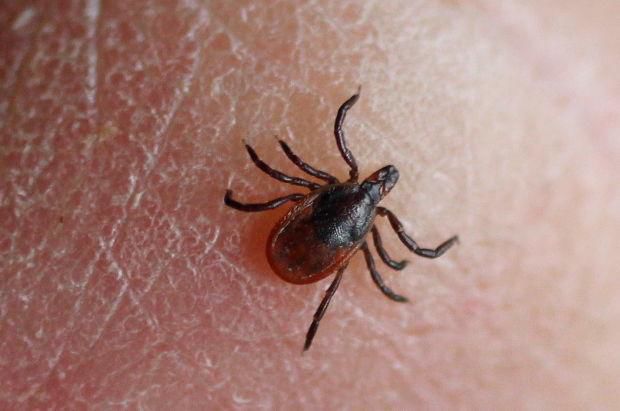Back Home by Chris Hardie
» Download this column as a Word document
» Download the photo that accompanies this story
» Chris Hardie’s headshot
I’ve had a few close calls over the years where I escaped serious injury while working on the farm. It can be a dangerous occupation.
But it wasn’t an overturned tractor, an attacking bull or a rotating shaft that took me down recently. Rather it was the bite from a tiny Ixodes scapularis, better known as the blacklegged tick or deer tick.

I joined the estimated 300,000 people each year who are diagnosed with Lyme disease — an infectious ailment caused by a bacterial infection carried by the deer tick.
Anyone who goes outdoors in Wisconsin or Minnesota, you should be familiar with it. As someone who works outside on almost a daily basis, I am pretty diligent about checking for ticks.
If you remove them within 36 to 48 hours, the chances of infection are much lower. Over the years, I’ve discovered some embedded ticks and have taken a preventative course of antibiotics.
This must have been a sneak attack. I’ve had a few ticks crawling on me this spring — as I always do — but have not seen any attached, much less embedded. I also had no bullseye rash, another symptom of Lyme. But I’ve since discovered 30% to 40% of people who get Lyme never get a rash.
At first, I thought my slight fever was my body’s reaction to working a little too hard on a hot and humid day. Maybe I overdid it just a bit.
I felt a little better the next morning, but that night my fever soared to more than 103 degrees and I developed chills and body aches.
I have what I consider to be a fairly high tolerance for pain and seldom take sick days. The old farm kid in me says to push through and get it done. So even after the first night of fever I was outside the next day finishing some yard work. I figure a good sweat never hurts you.
Well, there’s a good sweat resulting from physical exertion and then there’s uncontrollable sweating. My wife Sherry put an extra layer of sheets on my side of the bed and towels on the pillows — and I still had to change in the middle of the night. I alternated between chills and hot flashes, but I never stopped sweating.
I’m used to some body pain, but combined with the fatigue and the fever, we knew something wasn’t right. So even though I had none of the other symptoms, I was treated as a COVID-19 patient at the clinic because of the fever. The next day the blood test came in and it was positive for Lyme.
I’m amazed at how much damage a tiny tick can do. If left untreated, Lyme can spread to the joints, heart and nervous system.
As of this writing, I’m starting my second day of a 10-day course of doxycycline, one of the recommended treatments for Lyme. I’m already feeling a little better and hope to soon do more than simply sweat and sleep. But there’s disagreement in the medical community about the long-term health impact of Lyme.
A little prevention is always better, but right now our canine companions have a leg or two up on us. While there is a Lyme vaccine for dogs, there are no vaccines for humans. An early Lyme vaccine for humans was pulled from the market in 2002. Current trials for a new human vaccine still have a few years left.
So for now, the best we can do is to treat clothing with the appropriate repellents and continue to check for ticks.
Trust me. You don’t want Lyme.
Chris Hardie spent more than 30 years as a reporter, editor



